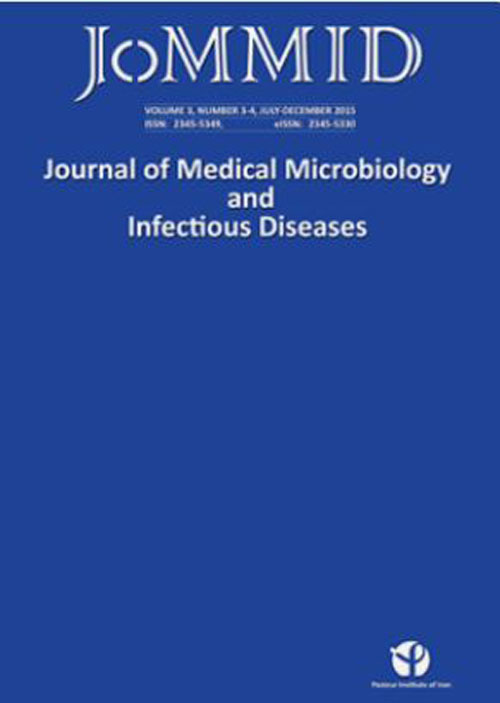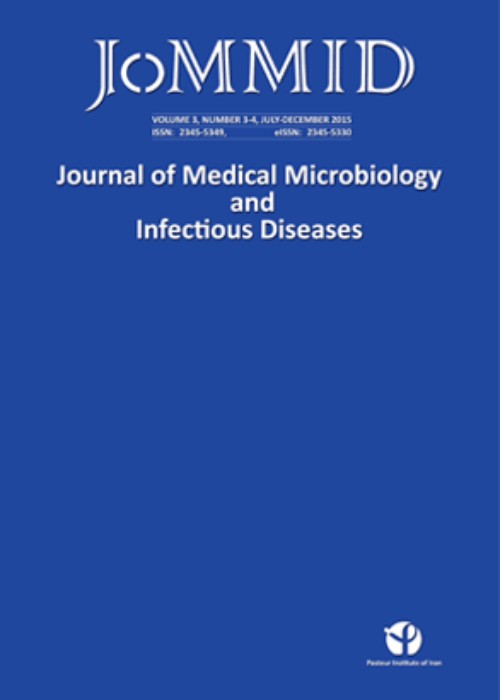فهرست مطالب

Journal of Medical Microbiology and Infectious Diseases
Volume:10 Issue: 1, Winter 2022
- تاریخ انتشار: 1401/01/24
- تعداد عناوین: 8
-
-
Pages 1-9Introduction
Severe acute respiratory syndrome coronavirus 2 (SARS-CoV-2) spilled over to humans via wild mammals, entering the host cell using angiotensin-converting enzyme 2 (ACE2) as receptor through Spike (S) protein binding. While SARS-CoV-2 became fully adapted to humans and globally spread, some mammal species were infected back. The present study evaluated the potential risk of mammals becoming hosts for SARS-CoV-2 through bioinformatics prediction based on ACE2 receptors.
MethodsWe used evolutionary bioinformatic approaches and comparative analysis of ACE2 critical residues that bind SARS-CoV-2 S-protein and predicted potential SARS-CoV-2 hosts among mammals and assessed their risk.
ResultsACE2 phylogenetic tree placed primates close to rodents and rabbits. Felines, rodents, and rabbits had higher ACE2 similarities than human ACE2 (hACE2). Farmed animals, such as bovids, swine, and equids, had similar ACE2 compared to hACE2; however, these animals showed low SARS-CoV-2 susceptibility. Some cetaceans also presented high similarities in ACE2 key residues with hACE2.
ConclusionHere, we showed wild and domestic mammals with a low divergence of ACE2 compared to humans, discussing their possible chance of being infected, especially those animals kept as livestock or pets. Regarding the feasible transmission through contaminated water, cetaceans can be at risk of SARS-CoV-2 infection. Extensive surveillance of SARS-CoV-2 should be applied to prevent new coronavirus outbreaks and preserve mammals from infectious threats.
Keywords: SARS-CoV-2, Coronavirus, ACE2, Mammals, Wildlife -
Pages 10-13Introduction
In HIV-associated tuberculosis cases, identifying nontuberculous Mycobacteria (NTM) from clinical samples has become essential regarding patients’ treatment and prognosis. This study aims to determine the prevalence of different Mycobacteria species from immunocompromised and immunocompetent patients with suspected tuberculosis attending a tertiary care hospital in Kolkata, India.
MethodsClinical samples from 112 suspected tuberculosis patients were examined by direct microscopy after Ziehl–Neelsen staining. After culture in BacT/ALERT 3D mycobacterial culture system, identification of the causative agents was performed using the GenoType MTCM system.
ResultsCulture positivity was higher in immunocompromised patients than in immunocompetent in both pulmonary and extrapulmonary samples. In smear-negative samples, culture positivity in immunocompromised patients (50%) was much higher than in immunocompetent patients (26.67%). Of 78 samples, four were NTMs (5.13%), including 1 M. avium, 1 M. abscessus, and 2 M. fortuitum, and 74 were Mycobacterium tuberculosis (MTBC). Two NTMs belonged to immunocompromised patients and two to immunocompetent individuals. The chance of Mycobacterial infection was higher in patients with a lower CD4 count. Both NTMs found in the immunocompromised group were from patients with a CD4 count<100.
ConclusionThe present study showed that the MTBC is still the primary causative agent in pulmonary and extrapulmonary tuberculosis in this part of India.
Keywords: Tuberculosis, NTM, Immunocompromised, CD4 count -
Pages 14-18Introduction
The occurrence of urinary tract infections (UTIs) caused by the group B Streptococcus (GBS) in females is well documented. On the contrary, the prevalence amongst males is infrequent, and studies from the Indian subcontinent are limited. This study aimed to determine the occurrence of GBS bacteriuria and its antibiotic susceptibility profile amongst male patients.
MethodsClean-catch, midstream, catheterized, or voided urine samples from patients were used for the study. Urinary samples from patients either admitted or attended to a tertiary care center in Southwest India were promptly sent to the laboratory for culture, identification, and antibiotic susceptibility test.
ResultsA total of 16,190 urine specimens were processed during the 1-year study period, of which 45 patients (0.27%), including 30 females (0.19%) and 15 males (0.09%), had GBS bacteriuria. The patients were mainly in the 19-45 years old group (53%). The most typical comorbidity was type 2 diabetes mellitus (42%). The majority of the GBS isolates from male patients (>80%) were susceptible to benzylpenicillin, ceftriaxone, ampicillin, and cotrimoxazole. The isolates showed the least susceptibility to tetracycline (26.1%)
ConclusionThough GBS-associated UTI amongst male patients is uncommon, antimicrobial resistance amongst S. agalactiae isolates is widespread. Nevertheless, antimicrobial resistance rates differ depending on the geographical areas and study duration. Considering the emergence of drug resistance in GBS, culture and antibiotic susceptibility testing patterns of all the strains of GBS, even in asymptomatic patients with a low count, are recommended.
Keywords: Streptococcus agalactiae, Urinary tract infections, Bacteraemia, males, Antimicrobial resistance -
Pages 19-23Introduction
This study aimed to determine the frequency of extended-spectrum beta-lactamases (ESBL) and different drug resistance phenotypes in Enterobacteriaceae isolated from clinical specimens in Gonbad-e Kavus, Golestan Province.
Methods220 clinical samples of urine, blood, pus, sputum, CSF, body fluids, and ear and eye discharge were collected during six months from April to September 2021 at a referral hospital. The samples were cultured on blood and MacConkey agar and incubated overnight at 37 °C. Standard biochemical tests and the API20E enteric identification system were used to identify bacteria. The Kirby-Bauer disk diffusion method determined the antibiotic resistance pattern, and the phenotypic confirmatory test was used for detecting ESBL producers.
Results108 Enterobacteriaceae isolates were identified from different clinical specimens out of the samples. The isolates were Escherichia coli (36.1%), Klebsiella pneumonia (25%), Enterobacter cloacae (18.5%), Citrobacter freundii (11.1%) and Proteus mirabilis (9.2%). The highest resistance and susceptibility among the isolates belonged to sulfamethoxazole-trimethoprim (68.5%) and meropenem (11.1%), respectively. The highest prevalence of multidrug-resistant (MDR) and ESBL were observed in E. coli and Proteus mirabilis isolates.
ConclusionsIn this study, the high frequency of MDR phenotypes in the isolates may suggest an increasing trend of antibiotic resistance in Enterobacteriaceae. This could greatly impact the management and treatment of infections caused by these drug-resistant bacteria. Therefore, infection-control measures and continuous monitoring is recommended for controlling the spread of ESBL-producing strains in different geographical areas.
Keywords: Beta-lactamases, Drug-resistant, Enterobacteriaceae, Prevalence -
Pages 24-29Introduction
The members of the genus Tanacetum are important medicinal plants. This study investigated the chemical composition and antibacterial activity of Tanacetum lingulatum and Tanacetum polycephalum essential oils on human infectious bacteria.
MethodsThe aerial part of two plants were collected from Urmia Province, Iran. The essential oils were extracted using a Clevenger device. The antibacterial effect of essential oils was determined using the disc diffusion assay, minimum inhibitory concentration (MIC), and minimum bactericidal concentration (MBC) by serial dilution method. Also, free radical scavenging activity by 2,2-diphenyl-1-picrylhydrazyl (DPPH) was examined. Chemical composition was measured using the Gas Chromatography-Mass Spectrometry (GCMS).
ResultsThe major constituents in T. polycephalum and T. lingulatum essential oils were 1,8- cineole and camphor, respectively. The highest sensitivity (MIC of 0.312 μg mL- ( was observed with T. polycephalum against Bacillus subtilis. The lowest IC50 (most potent radical scavenging activity) belonged to T. lingulatum essential oil. Pseudomonas aeruginosa and Streptococcus pyogenes showed resistance to T. lingulatum essential oil.
ConclusionThe essential oil of T. polycephalum and T. lingulatum are potential natural antibacterials to treat human pathogenic bacteria and can be used as alternatives to produce antimicrobial agents.
Keywords: Tanacetum genus, Infectious bacteria, Phytochemical -
Pages 30-35Introduction
Crimean-Congo Hemorrhagic Fever (CCHF) is a zoonotic viral infection transmitted mainly via CCHF virus-infected ticks between vertebrate hosts. The disease occurs in almost all provinces of Iran. This study investigated the CCHFV infection in hard ticks collected from livestock in the Sistan region of Sistan and Baluchestan Province, southeast of Iran.
MethodsIn this study, ticks were collected from 220 livestock, including 150 sheep, 50 goats, 20 cows in five counties of Sistan Province (Zabol, Zehak, Hirmand, Nimruz, and Hamun). The ticks were identified under a stereomicroscope according to valid morphological keys. A reverse transcription-polymerase chain reaction (RT-PCR) method was used to detect the CCHFV genome via amplifying the S segment.
ResultsAmong 100 selected ticks, RT-PCR revealed no CCHFV infection.
ConclusionsAlthough no ticks were positive for CCHFV, it should be recalled that Sistan and Baluchestan province is among the highly endemic CCHF foci. As a result, further investigation and larger sample sizes are required to confirm our outcome. According to the hypothesis that direct contact with viremic livestock is more significant than tick bites in the viral transmission, more serological and molecular screening should be performed on high-risk individuals, e.g., slaughterhouse staff, ranchers, farmers, and veterinarians in the Sistan region.
Keywords: Crimean-Congo hemorrhagic fever, Hard tick, RT-PCR, Sistan, Iran -
Pages 36-41Introduction
In the past decade, multidrug-resistant Acinetobacter baumannii has become one of the most critical challenges in treating infected patients. The AdeABC efflux pump is the most important among the various resistance mechanisms. This pump can force various antibiotics and ethidium bromide out of the bacterial cell to the surrounding environment.
MethodsIn this study, nine A. baumannii clinical isolates were isolated and identified using different biochemicals (catalase, oxidase, TSI, hemolysis, growth at 44°C, and indole) and molecular (blaOxa51 gene) tests. Following the antibiogram test, the antibiotic resistance changes in the isolates in the presence and absence of efflux pump inhibitor (CCCP) were determined for tetracycline, and ciprofloxacin AdeABC efflux pump genes, including adeA, adeB, and adeC, were amplified by PCR. Finally, the presence of the AdeABC efflux pump was investigated using the agar ethidium-bromide cartwheel method (AEBCM).
ResultsAccording to the antibiogram test, all isolates were MDR. In the presence of efflux pump inhibitor, a reduced resistance for tetracycline was observed, but not for ciprofloxacin. The AdeABC efflux pump genes were detected in all isolates. An increase in the AdeABC pump activity in four isolates was confirmed using AEBCM.
ConclusionAEBCM, a fast and convenient tool for assessing the ethidium bromide secretion in various bacteria, provides a quick diagnosis and treatment of multidrug-resistant bacteria.
Keywords: Agar ethidium bromide cartwheel, AdeABC, Acinetobacter baumannii -
Pages 42-47Introduction
Calf diarrhea is one of the significant problems in dairy farms associated with treatment costs and reduced livestock production. Salmonellae are among the most common and the major causative agents of diarrhea in calves and humans. The present study was carried out to isolate and identify Salmonella in fecal samples of calves in industrial dairy farms of Hamedan and to determine antibiotic resistance profiles of the probable isolates.
MethodsSalmonella were presumptively isolated based on the cultural characteristics and biochemical tests, and the identity of the isolates was further confirmed using genus- and serotype-specific PCR assays. Kirby-Bauer disk diffusion method was performed to determine antibiotic resistance profiles of the isolates.
ResultsOut of 120 stool samples collected from 8 industrial farms, 22 (18.33%) isolates possessing rfbJ, fliC and fljB genes were identified as Salmonella Typhimurium serotype. Antibiotic susceptibility test revealed all isolates (100%) were susceptible to gentamicin, amoxicillin-clavulanic acid, kanamycin, and ciprofloxacin and resistant against cotrimoxazole, cefazolin, and cefixime.
ConclusionTo our knowledge, this study was the first report of Salmonella infection in Hamedan's dairy farms, indicating a relatively high prevalence rate of S. Typhimurium infection as the only detected serotype. Antibiotic resistance should also be considered a severe public health concern. Thus, effective hygiene measures should be adopted to prevent or reduce the infection, and monitoring antibiotic susceptibility is required to choose the drug of choice for treatment.
Keywords: Calf, Diarrhea, Salmonella, Typhimurium, PCR, Antibiotic resistance


